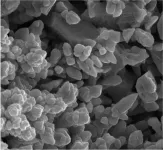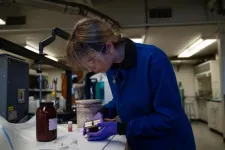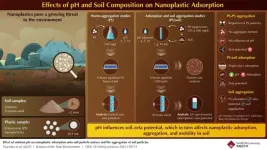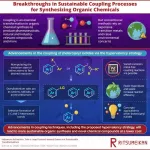A step toward cleaner iron extraction using electricity
2025-04-09
(Press-News.org) Iron and its alloys, such as steel and cast iron, dominate the modern world, and there’s growing demand for iron-derived products. Traditionally, blast furnaces transform iron ore into purified elemental metal, but the process requires a lot of energy and emits air pollution. Now, researchers in ACS Energy Letters report that they’ve developed a cleaner method to extract iron from a synthetic iron ore using electrochemistry, which they say could become cost-competitive with blast furnaces.
"Identifying oxides which can be converted to iron metal at low temperatures is an important step in developing fully electrified processes for steelmaking," says Paul Kempler, the study’s corresponding author.
Electrochemical ironmaking isolates the metal by passing electricity through a liquid that holds iron-containing feedstocks. Compared to high-temperature blast furnaces, the electrochemical process could significantly reduce air pollution emissions, such as greenhouse gases, sulfur dioxide and particulate matter, and suggests considerable energy savings. Previously, Kempler and colleagues used this process to convert solutions containing solid iron(III) oxide particles and sodium hydroxide directly into elemental iron at temperatures around 176 to 194 degrees Fahrenheit (80 to 90 degrees Celsius). However, when some natural iron ores with irregularly sized, dense particles and impurities were tested, this low-temperature process wasn’t selective enough. So, Kempler and a new team of researchers led by Anastasiia Konovalova and Andrew Goldman wanted to understand which iron ore-like feedstocks could support scalable growth of the process.
First, the researchers prepared high surface area iron oxide particles with internal holes and connective cavities to investigate how the nanoscale morphology of the particles impacted the electrochemical reaction. Then, they converted some of these into micrometer-wide iron oxide particles to mimic the morphology of natural ores. These particles contained only a few trace impurities, such as carbon and barium. The team designed a specialized cathode to pull iron metal from a sodium hydroxide solution containing the iron oxide particles as current passed through it. In experiments, dense iron oxides were reduced, or converted into elemental iron, most selectively at a current density of 50 milliamperes per square centimeter, similar to rapidly charging lithium-ion batteries. Conversely, loose particles with higher porosity, and thus higher surface area, facilitated more efficient electrochemical iron production, as compared to those made to resemble the less porous natural iron ore hematite.
The researchers evaluated the potential cost of their electrochemical ironmaking method. At the current density used in the experiments, they estimated that iron could be produced at less than $600 per metric ton ($0.60 per kilogram), which is comparable to traditional ironmaking. The study showed that much higher current densities, up to 600 milliamperes per square centimeter, similar to those used in industrial electrolysis cells, could be achieved when using particles with nanoscale porosity. Further advances in electrochemical cell design and techniques to make iron oxide feedstocks more porous will be required before the technology sees commercial adoption.
The authors acknowledge funding from the U.S. Department of Energy, Office of Science, Office of Basic Energy Sciences.
The paper’s abstract will be available on April 9 at 8 a.m. Eastern time here: http://pubs.acs.org/doi/abs/10.1021/acsenergylett.5c00166
###
The American Chemical Society (ACS) is a nonprofit organization founded in 1876 and chartered by the U.S. Congress. ACS is committed to improving all lives through the transforming power of chemistry. Its mission is to advance scientific knowledge, empower a global community and champion scientific integrity, and its vision is a world built on science. The Society is a global leader in promoting excellence in science education and providing access to chemistry-related information and research through its multiple research solutions, peer-reviewed journals, scientific conferences, e-books and weekly news periodical Chemical & Engineering News. ACS journals are among the most cited, most trusted and most read within the scientific literature; however, ACS itself does not conduct chemical research. As a leader in scientific information solutions, its CAS division partners with global innovators to accelerate breakthroughs by curating, connecting and analyzing the world’s scientific knowledge. ACS’ main offices are in Washington, D.C., and Columbus, Ohio.
Note: ACS does not conduct research but publishes and publicizes peer-reviewed scientific studies.
Follow us: Facebook | LinkedIn | Instagram
END
ELSE PRESS RELEASES FROM THIS DATE:
2025-04-09
University of Oregon chemists are bringing a greener way to make iron metal for steel production closer to reality, a step towards cleaning up an industry that’s one of the biggest contributors to carbon emissions worldwide.
Last year UO chemist Paul Kempler and his team reported a way to create iron with electrochemistry, using a series of chemical reactions that turn saltwater and iron oxide into pure iron metal.
In their latest work, they’ve optimized the starting materials for the process, identifying which kinds of iron oxides will make the chemical reactions the most cost-effective. That’s a key ...
2025-04-09
Plastics are everywhere—from packaging and textiles to electronics and medical devices. As plastic waste breaks down, it releases microscopic particles that can penetrate our ecosystems, hinder plant growth, and potentially transfer harmful pollutants to organisms, including humans. Therefore, these plastic particles are a potential threat to the ecosystem, especially in their nanoparticulate form (1–100 nm diameter), which can penetrate the environment through different routes, including the soil beneath our feet.
With this in mind, a team of researchers from Japan set out to study the migration behavior of nanoplastics ...
2025-04-09
Coupling reactions are among the most transformative tools in organic chemistry, enabling the formation of crucial chemical bonds in pharmaceuticals, agrochemicals, and advanced materials. Since their introduction, they have been one of the backbones of modern organic synthesis. However, these methods have long relied on environmentally taxing transition metal catalysts, such as palladium, which are often scarce, costly, and generate unwanted byproducts.
The limitations of conventional coupling methods have prompted researchers to seek alternative strategies that better align with the principles of green and sustainable chemistry ...
2025-04-09
Amid deepening inequalities and escalating crises, including climate change, biodiversity loss and pollution, a new United Nations report presents a bold approach for change.
The 2025 Interconnected Disaster Risks report, Turning Over a New Leaf, issued by the UN University’s Institute for Environment and Human Security (UNU-EHS), shifts focus from diagnosing problems to mapping out solutions. It establishes that many of today’s solutions are surface-level fixes, and that to create ...
2025-04-09
COLUMBUS, Ohio – Researchers at The Ohio State University Wexner Medical Center and College of Medicine have discovered a new way that neurons act in neurodegeneration by using human neural organoids – also known as “mini-brain” models – from patients with frontotemporal lobar degeneration (FTLD).
Understanding this new pathway could help researchers find better treatments for FTLD and Alzheimer’s, the two most common forms of dementia that lead to cognitive decline.
Researchers used advanced techniques to study neurons from ...
2025-04-09
A pivot from fossil fuels to clean energy technologies by 2060 would improve energy security and reduce trade risks for most nations, according to an April 9 study in Nature Climate Change.
Lithium, nickel, cobalt, copper, and rare earth minerals are among the prized materials for countries and corporations racing to secure supplies for energy systems that do not add greenhouse gases to our atmosphere. Unlike fossil fuels, natural reserves of these materials are most concentrated in the Global South, shuffling the geopolitics of energy and global trade.
“Most people ...
2025-04-09
New research from the University of Sydney has revealed poor oral health is significantly associated with higher instances of migraines, abdominal and body pain in women.
Published in Frontiers in Pain Research, the world-first study identified specific oral microbes correlated with certain pain conditions, suggesting a potential relationship between the oral microbiome and the nervous system.
The findings highlight the importance of good oral health to potentially mitigate pain and improve overall wellbeing, prompting further exploration into the role of oral microbiota in chronic unexplained ...
2025-04-09
A review published in The Laryngoscope indicates that climate change’s effects on pollen seasons and concentrations are contributing to increasing rates of allergic rhinitis, or hay fever.
When investigators assessed research published between 2000 and 2023, they identified 30 studies that reported on the current epidemiological state of allergic rhinitis, described factors related to climate change, and observed how global warming is affecting pollen seasons and allergy symptoms.
Sixteen studies reported longer pollen seasons and/or higher pollen concentrations related to climate change. As an example, total pollen emissions in the U.S. are projected to increase by 16–40% ...
2025-04-09
Several states, including Georgia, offer state-funded pre-kindergarten programs to students regardless of their family’s income. New research in Economic Inquiry investigates whether such programs offer long-lasting academic benefits to all students.
Using enrollment lottery data from a large school district in metro Atlanta, investigators found that lottery-winning enrollees of school-based pre-kindergarten entered kindergarten more prepared in both math and reading than non-winning peers. Gains tended to fade by the end of kindergarten, however, and some negative achievement effects ...
2025-04-09
Hydrogels, which are soft materials formed by crosslinking polymers, could have a variety of medical applications. In research published in Advanced Science, investigators developed an injectable hydrogel containing components of fish swim bladders and used it to repair damaged heart tissue.
The fish swim bladder is an organ that aids fish in floating in water and is composed of collagen, glycosaminoglycans, and elastin, closely resembling parts of the human heart.
Experiments revealed that the researchers’ fish swim bladder–based hydrogel enhances cardiac cell adhesion and stretching while promoting new ...
LAST 30 PRESS RELEASES:
[Press-News.org] A step toward cleaner iron extraction using electricity







